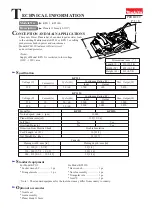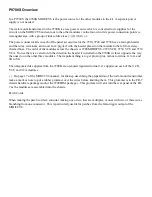
OPEN
Cardiac mesenchymal progenitors differentiate into
adipocytes via
Klf4
and
c-Myc
D Kami
1
, T Kitani
2
, T Kawasaki
2
and S Gojo*
,1
Direct reprogramming of differentiated cells to pluripotent stem cells has great potential to improve our understanding of
developmental biology and disorders such as cancers, and has implications for regenerative medicine. In general, the effects of
transcription factors (TFs) that are transduced into cells can be influenced by pre-existing transcriptional networks and epigenetic
modifications. However, previous work has identified four key TFs,
Oct4, Sox2, Klf4
and
c-Myc
, which can reprogram various
differentiated cells to generate induced pluripotent stem cells. Here, we show that in the heart, the transduction of cardiac
mesenchymal progenitors (CMPs) with Klf4 and c-Myc (KM) was sufficient to drive the differentiation of these cells into adipocytes
without the use of adipogenic stimulation cocktail, that is, insulin, 3-isobutyl-1-methylxanthine (IBMX) and dexamethasone.
KM-transduced CMPs exhibited a gradually increased expression of adipogenic-related genes, such as
C/Ebp
α
,
Ppar
γ
and
Fabp4
,
activation of the peroxisome proliferator-activated receptor (PPAR) signaling pathway, inactivation of the cell cycle-related pathway
and formation of cytoplasmic lipid droplets within 10 days. In contrast, NIH3T3 fibroblasts, 3T3-L1 preadipocytes, and bone
marrow-derived mesenchymal stem cells transduced with KM did not differentiate into adipocytes. Both
in vitro
and
in vivo
cardiac
ischemia reperfusion injury models demonstrated that the expression of KM genes sharply increased following a reperfusion
insult. These results suggest that ectopic adipose tissue formation in the heart following myocardial infarction results from CMPs
that express KM following a stress response.
Cell Death and Disease
(2016)
7,
e2190; doi:10.1038/cddis.2016.31; published online 14 April 2016
Adipocyte differentiation, that is, adipogenesis, has been
extensively investigated, and its regulation via transcriptional
cascades has been described for
in vitro
model systems.
The
adipogenic transcriptional cascade consists of two waves. The
first wave converges at the CCAAT/enhancer-binding protein
(C/Ebp)
β
/
γ
, which induces the second wave consisting of
nuclear receptor peroxisome proliferator-activated receptor
(Ppar)
γ
and C/EBP
α
activity. In addition,
c-Myc
is periodically
expressed during the early phase of adipogenesis.
Krüppel-
like factor (
Klf
) family members include both repressors and
activators of adipogenesis, and are activated during the first
wave.
KLF4 and c-MYC (KM) coordinately bind the promoters
of genes that are activated during the reprogramming of
differentiated cells to pluripotency.
Whether KM work together
in adipogenesis has not been examined.
Mesenchymal stem cells (MSCs) are multipotent cells with
a capacity to differentiate to mesodermal lineages and show
a vigorous proliferation capacity under conventional culture
conditions.
The criteria for identifying MSCs include adher-
ence to a plastic dish, a characteristic surface profile and
differentiation capacity
in vitro
Although most prior reports
have identified bone marrow as the origin for MSCs, other
organs including adipose tissue
and the heart
also harbor
fibroblasts that fulfill the criteria for MSCs. MSCs derived from
different organs demonstrate varying capacities for proliferation
and differentiation.
Although several reports have demon-
strated adipose tissue formation in the myocardium following
reperfusion therapy for ischemic heart diseases,
it is
unclear how fat depositions in the heart are generated.
Direct reprogramming of differentiated cells using specific
transcription factors (TFs) opens the door to understanding
the mechanisms underlying development and the pathogen-
esis of various disorders, and has applications in regenerative
medicine.
Transdifferentiation
or
direct
conversion,
which occurs when a differentiated cell type is reprogrammed
to another cell type, could be implemented via the same
strategy of using a set of TFs to generate cardiomyocytes,
neurons and so on.
Moreover, there are similarities and
overlaps between the pathways for the generation of induced
pluripotent stem cells (iPSCs) and tumorigenesis, such as a
1
Department of Regenerative Medicine, Kyoto Prefectural University of Medicine, Kyoto, Japan and
2
Department of Cardiovascular Medicine, Graduate School of Medical
Science, Kyoto Prefectural University of Medicine, Kyoto, Japan
*Corresponding author: S Gojo, Department of Regenerative Medicine, Kyoto Prefectural University of Medicine, 465 Kajii cho, Kamigyo ku, Kyoto 602-8566, Japan.
Tel: +81 75 251 5752; Fax: +81 75 251 5910; E-mail: [email protected]
Received 09.7.15; revised 19.1.16; accepted 20.1.16; Edited by D Aberdam
Abbreviations:
C/EBP, CCAAT/enhancer-binding protein; PPAR, peroxisome proliferator-activated receptor; Klf, Krüppel-like factor; KM, KLF4 and c-MYC; MSC,
mesenchymal stem cell; TF, transcription factor; iPSC, induced pluripotent stem cell; OSKM,
Oct4, Sox2, Klf4
and
c-Myc
; CMP, cardiac mesenchymal progenitor; IRI,
ischemic reperfusion injury; MI, myocardial infarction; qRT-PCR, quantitative reverse transcription polymerase chain reaction; PCA, principal component analysis; PC,
principal component; GO, gene ontology; KEGG, Kyoto Encyclopedia of Genes and Genomes; LAD, left anterior descending artery; AON, area of necrosis; AAR, area
at risk; RA, remote area; ROS, reactive oxygen species; LV, left ventricular; RAAS, renin
–
angiotensin
–
aldosterone system; NRX, nucleoredoxin; Dvl, dishevelled; bFGF,
basic fibroblast growth factor; IBMX, 3-isobutyl-1-methylxanthine; DMEM, Dulbecco's modified Eagle
’
s medium; FBS, fetal bovine serum; MEM, minimum essential media;
KO-DMEM, knockout DMEM; PFA, paraformaldehyde; NIA array analysis, National Institute on Aging array analysis; DAVID, Database for Annotation, Visualization and
Integrated Discovery; GEO, Gene Expression Omnibus; TTC, 2,3,5-triphenyltetrazolium chloride
Citation: Cell Death and Disease (2016) 7, e2190; doi:10.1038/cddis.2016.31
&
2016 Macmillan Publishers Limited All rights reserved 2041-4889/16






























